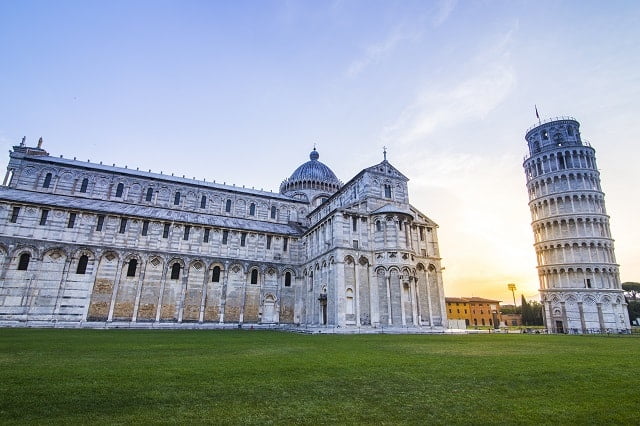Italy is a country with an abundance of rich cultural heritage, diverse landscapes, and world-renowned cuisine. Exploring this beautiful country can be an overwhelming experience, which is why seeking travel recommendations is essential.
From iconic cities to hidden gems, Italy has something to offer every traveler. In this article, we will provide you with valuable insights into the best places to visit in Italy, including must-try dishes, off-the-beaten-path destinations, cultural experiences, and practical tips for a successful Italian vacation.
When it comes to Italian travel recommendations, there’s no shortage of options to explore. From the ancient ruins of Rome to the charming canals of Venice and the rolling hills of Tuscany, Italy offers a wide range of experiences for travelers. Whether you’re a history buff, a food enthusiast, or an outdoor adventurer, Italy has something for everyone.
As we delve into this article’s sections on top cities to visit in Italy, hidden gems and off-the-beaten-path destinations, best Italian dishes to try, cultural and historical experiences, outdoor and adventure activities, accommodation and transportation tips, as well as helpful tips for a successful Italian vacation – you’ll discover the ultimate guide for planning your next Italian getaway. Get ready to immerse yourself in all that Italy has to offer.
Top Cities to Visit in Italy
Italy is a country renowned for its rich history, stunning architecture, and vibrant culture. When planning a trip to Italy, it’s essential to consider the top cities to visit in order to make the most of your experience. Here are some of the most popular and iconic cities in Italy that should be at the top of your travel itinerary:
- Rome: Known as the “Eternal City,” Rome is brimming with ancient history and iconic landmarks such as the Colosseum, Roman Forum, and Vatican City. Visitors can also indulge in delicious Italian cuisine and gelato while exploring charming cobblestone streets.
- Florence: As the birthplace of the Renaissance, Florence is a treasure trove of art and architecture. Must-visit attractions include Michelangelo’s David at the Galleria dell’Accademia, the Uffizi Gallery, and the magnificent Duomo.
- Venice: Famed for its picturesque canals and romantic atmosphere, Venice offers visitors a unique experience unlike any other. From taking a gondola ride along the Grand Canal to visiting St. Mark’s Square and Basilica, there’s no shortage of enchanting sights.
- Milan: As Italy’s fashion and design capital, Milan is a dynamic city known for its chic boutiques, historic landmarks like the Duomo di Milano, and world-class museums such as Pinacoteca di Brera.
Each of these cities offers its own distinct charm and appeal, making them essential stops on any Italian adventure. Whether you’re captivated by ancient history or interested in modern culture, these cities have something to offer every type of traveler.
Hidden Gems and Off-the-Beaten-Path Destinations
When planning a trip to Italy, many tourists are drawn to the well-known cities of Rome, Florence, and Venice. However, Italy offers a plethora of hidden gems and off-the-beaten-path destinations that are equally captivating and worth exploring.
One such destination is Cinque Terre, a picturesque coastal area known for its colorful villages and stunning hiking trails. This UNESCO World Heritage Site allows visitors to immerse themselves in the beauty of the Italian Riviera while enjoying fresh seafood and local wine.
Another hidden gem in Italy is Matera, famous for its ancient cave dwellings and rock churches. This unique city has been designated as a European Capital of Culture and offers an intriguing glimpse into Italy’s past. Additionally, the island of Sicily boasts not only beautiful beaches but also a rich history and diverse culture. Visitors can explore ancient Greek temples, charming towns, and indulge in Sicilian cuisine that is distinct from the rest of Italy.
Exploring these off-the-beaten-path destinations provides travelers with authentic experiences that allow them to connect with Italian culture on a deeper level. Whether it’s wandering through narrow alleys, interacting with locals, or savoring traditional dishes, these hidden gems offer a truly immersive experience that goes beyond the typical tourist attractions.
| Destination | Main Attractions |
|---|---|
| Cinque Terre | Colorful villages, coastal hiking trails |
| Matera | Ancient cave dwellings, rock churches |
| Sicily | Ancient Greek temples, diverse cuisine |
Best Italian Dishes to Try
When visiting Italy, one of the highlights of the trip is undoubtedly the food. Italian cuisine is renowned worldwide for its delicious flavors and fresh ingredients. From pasta to pizza to gelato, there are countless dishes that every traveler must try in Italy.
Must-Try Italian Dishes
It goes without saying that pasta should be at the top of your list. Whether it’s a classic spaghetti carbonara in Rome, a hearty lasagna in Bologna, or a creamy fettuccine Alfredo in Florence, you simply can’t go wrong with any pasta dish in Italy. Another must-try is pizza, particularly in Naples where it originated. The authentic Neapolitan pizza is made with simple but high-quality ingredients and cooked in a wood-fired oven.
Of course, no trip to Italy would be complete without indulging in gelato. This creamy frozen dessert comes in a plethora of flavors, from traditional ones like pistachio and stracciatella to more unique options like ricotta and fig. Finally, don’t miss out on trying regional specialties such as risotto in Milan, arancini in Sicily, or ribollita soup in Tuscany.
Best Restaurants and Food Experiences
While wandering through the charming streets of Italian cities, be sure to seek out local restaurants and trattorias for an authentic culinary experience. Some of the best food experiences can be found off the beaten path – from family-owned osterias serving homemade gnocchi to street vendors selling porchetta sandwiches at outdoor markets.
Additionally, consider taking a cooking class or food tour during your visit to Italy. These experiences allow you to learn about Italian culinary traditions and techniques while enjoying delicious tastings along the way. Whether it’s making fresh pasta from scratch or exploring a local market with a knowledgeable guide, these food-focused activities provide insight into the heart of Italian gastronomy.
Cultural and Historical Experiences
Italy is renowned for its rich cultural and historical heritage, making it a perfect destination for travelers interested in immersing themselves in the country’s past. One of the must-visit historical sites in Italy is the Colosseum in Rome, an ancient amphitheater that once hosted gladiator contests and other public spectacles. This iconic landmark offers a glimpse into the grandeur of the Roman Empire and is a testament to Italy’s enduring legacy.
In addition to historical landmarks, Italy also boasts a wealth of cultural experiences, including vibrant festivals that celebrate various traditions and art forms. One such festival is the Venice Carnival, known for its elaborate masks and costumes. Held annually before Lent, this event brings together locals and tourists alike to partake in extravagant parades and masquerade balls, showcasing the opulence and creativity of Italian culture.
For travelers interested in delving deeper into Italy’s artistic legacy, there are numerous museums and galleries throughout the country that house masterpieces by renowned artists such as Michelangelo, Leonardo da Vinci, and Caravaggio. The Uffizi Gallery in Florence, for example, is home to an extensive collection of Renaissance art, including works by Botticelli and Raphael.
Visiting these cultural institutions provides an opportunity to appreciate Italy’s contributions to art history and gain insight into the creative genius of its most celebrated artists.
| Historical Site | Cultural Experience |
|---|---|
| The Colosseum in Rome | Venice Carnival |
| Museo Nacional del Prado in Madrid | Galleria Borghese in Rome |
Outdoor and Adventure Activities
Italy is not only famous for its rich history, art, and food, but also for its stunning natural landscapes and outdoor activities. Whether you’re a nature lover or an adventure seeker, Italy offers a wide range of outdoor experiences to enjoy. From the majestic Alps in the north to the breathtaking coastlines of the Amalfi Coast in the south, there are plenty of opportunities to explore the great outdoors.
Here are some outdoor and adventure activities to consider when traveling to Italy:
- Hiking: The Dolomites in northern Italy offer some of the best hiking trails in Europe. With its dramatic peaks, lush green valleys, and crystal-clear lakes, this mountain range is a paradise for hikers and outdoor enthusiasts.
- Cycling: Tuscany’s rolling hills and picturesque countryside make it an ideal destination for cycling. Explore charming medieval towns, vineyards, and olive groves as you pedal through this beautiful region.
- Water sports: Along the Amalfi Coast and the Italian Riviera, travelers can enjoy a variety of water sports such as kayaking, snorkeling, and sailing. The clear blue waters of the Mediterranean provide a perfect setting for aquatic adventures.
In addition to these activities, Italy also offers opportunities for rock climbing, skiing in the winter months, and even paragliding in certain regions. No matter what your outdoor interests may be, there’s something for everyone to enjoy amidst Italy’s stunning natural beauty.
Accommodation and Transportation Tips
Accommodation Tips
When visiting Italy, there are various options for accommodations that cater to different preferences and budgets. From luxurious hotels in major cities to charming agriturismi in the countryside, travelers can find the perfect place to stay. For those seeking a more intimate experience, boutique guesthouses in historic neighborhoods provide a cozy atmosphere and personalized service. It is advisable to book accommodations in advance, especially during peak travel seasons, to secure the best options.
Transportation Options
Italy offers an efficient and convenient transportation network that makes it easy for visitors to explore the country. The Italian railway system connects major cities and regions, allowing travelers to enjoy scenic train journeys while traveling between destinations. Renting a car provides flexibility and access to remote areas, particularly in the countryside and coastal regions. Additionally, local ferry services offer a picturesque way to navigate the coastal towns and islands of Italy.
Navigating Italian Cities
While exploring cities like Rome, Florence, and Venice, walking is often the best way to experience their charm and beauty. Many attractions are within walking distance of each other, allowing visitors to immerse themselves in the vibrant street life and architectural wonders. In some cases, public transportation such as buses or trams may be necessary for reaching specific landmarks or neighborhoods.
Driving Tips
For travelers planning to rent a car and drive in Italy, it is important to be aware of local traffic regulations and road conditions. Some areas have limited traffic zones (ZTL) where only authorized vehicles can enter, so it’s essential to research these restrictions before driving into city centers. Additionally, some towns have narrow streets that may not be suitable for larger vehicles or inexperienced drivers.
Helpful Tips for a Successful Italian Vacation
In conclusion, Italy is a destination that offers a wealth of experiences for travelers. From its iconic cities to its hidden gems, delectable cuisine, rich history and culture, and outdoor adventures, there is something for every type of traveler in Italy. When planning a trip to Italy, seeking recommendations and insider tips can greatly enhance the experience and ensure a successful vacation.
It is important to consider the best time to visit Italy in order to make the most of your trip. Whether it’s avoiding the peak tourist season or timing your visit to coincide with local festivals and events, planning your trip around the right time can greatly enrich your experience. Understanding Italian customs and etiquette as well as learning some basic Italian phrases can also go a long way in immersing yourself in the local culture.
Embracing the Italian way of life also means indulging in the culinary delights that Italy has to offer. Try not only the iconic dishes like pizza and pasta, but also explore regional specialties and seek out authentic dining experiences. Additionally, choosing accommodations that offer a more immersive experience such as agriturismi or boutique guesthouses can give you a taste of authentic Italian hospitality.
Ultimately, traveling in Italy should be about embracing the diverse experiences it has to offer – from exploring historical landmarks to enjoying outdoor adventures and savoring delicious cuisine. By following these helpful tips and seeking out personalized recommendations, travelers can make the most of their Italian vacation and create lasting memories.
Frequently Asked Questions
What is the best month to travel to Italy?
The best month to travel to Italy is during the shoulder seasons, which are typically in April to June and September to October. During these months, the weather is pleasant, the crowds are thinner, and accommodations are more affordable compared to the peak summer months.
What is the current travel advisory for Italy?
As of now, Italy has different travel advisories depending on the region and COVID-19 situation. It’s important to regularly check for updates from reputable sources like government travel advisories and the World Health Organization before planning a trip to Italy.
What are the current travel requirements to Italy?
The current travel requirements for Italy depend on the traveler’s country of origin and vaccination status. Generally, travelers may need to provide a negative COVID-19 test result or proof of vaccination upon arrival. Additionally, there may be specific entry requirements for each region within Italy, so it’s essential to research and confirm the necessary documentation before traveling.

I’m a passionate traveler, writer, and Italophile. My fascination with Italy’s history, art, and culture has led me on countless adventures across the Italian landscape. Through “I Live Italy,” I share my love for this extraordinary country and aims to inspire others to explore its boundless beauty.





